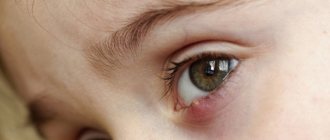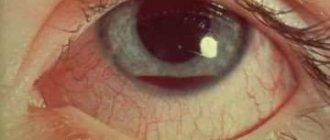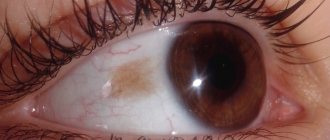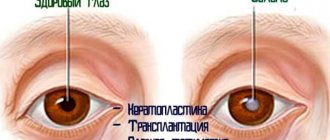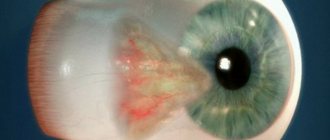The epicanthus is a small fold of skin on the inside of the eyelid, parallel to the nose. It covers the tear duct and does not affect the functioning of the organ of vision. Most often, this phenomenon is observed among representatives of the Mongolian race, which is why it is often called the “Mongolian fold.” In other nationalities, epicanthus is absent; its appearance may signal the development of some pathologies in the body. In some cases, the fold indicates a serious chromosomal disorder.
What is epicanthus?
This is a small fragment of skin on the inside of the eyelid. It covers the tear duct and visually the eyes look narrower. The fold runs from the bridge of the nose to the upper eyelid and is shaped like a crescent. Its main purpose is to protect the organ of vision from dust and pollution.
A similar feature in appearance is characteristic of the Asian population and residents of the Far North. For other nationalities, epicanthus is an anomaly. It is often seen in pregnant women or people with Down syndrome.
Epicanthus in anthropology
There are two popular versions of the appearance of the “Mongolian fold”:
- It is designed to protect the organ of vision and the tear duct from the effects of negative environmental factors. However, many anthropologists question this version. After all, epicanthus can be found in people living in favorable conditions, where there are no natural irritants;
- But the second assumption is more like reality. It is believed that the fold occurs when there is a wide bridge of the nose. At this point, the skin stretches, forming a small fold.
| Typically, epicanthus disappears with age. Even representatives of the older generation of the Mongoloid race lack the characteristic fold. |
If a skin formation is found in Europeans or Russians, then you should not immediately panic. Until the age of seven, this is a completely normal and harmless phenomenon. But the appearance of folds in older age can become a symptom of a developing pathology.
Why might epicanthus appear after blepharoplasty?
Sometimes you can see the opposite cases, when after surgical treatment the epicanthus does not go away, but appears or becomes even larger. Basically, this happens after blepharoplasty, which belongs to the group of complex ophthalmological interventions and requires professionalism and experience from the specialist. Unfortunately, cases of unsuccessful blepharoplasty are common.
We recommend: When is Deka Smart non-surgical blepharoplasty needed?
Epicanthoplasty is a surgical procedure, the favorable outcome of which almost entirely depends not on the patient and the structural features of the epicanthus, but on the experience of the specialist, who must take into account many factors.
In view of this, you need to choose proven Moscow clinics that employ surgeons with extensive experience. It is impossible to save on such procedures: almost always the high price of such operations allows for high quality of their implementation.
YouTube responded with an error: The request cannot be completed because you have exceeded your quota.
Rate this article:
- Related Posts
- What is smooth eye laser blepharoplasty?
- What is ultrasound blepharoplasty?
- How is non-surgical abdominal blepharoplasty performed?
- How is non-surgical blepharoplasty performed with mesoeye c71?
- Which is better: blepharoplasty or fillers?
- What is plasma non-ablative blepharoplasty?
Causes
Despite the fact that epicanthus is essentially harmless and protects the eye, in some cases it signals destructive processes in the body:
- Damage to the skin in the eye area, causing the formation of a large amount of scar tissue;
- Infectious pathologies passed from mother to infant during the intrauterine formation of the fetus;
- Chromosome type failure;
- Unhealthy lifestyle of a woman in this position: alcohol abuse, smoking;
- Dyne syndrome;
- The birth of a child earlier than the designated due date;
- Multiple pregnancy.
Most often, the appearance of a fold can be caused by a congenital anomaly that develops in babies when the mother has diseases of a genetic or physiological nature. Return to contents
Treatment
Treatment for strabismus should begin as early as possible. The equipment in many cases helps to make a diagnosis at the earliest stages, so if you suspect strabismus developing in an infant, it is important to immediately consult a doctor. Treatment is not carried out in newborn children. And after the child reaches five months, if strabismus is confirmed, therapy is started immediately.
Preventative examinations of infants by an ophthalmologist help detect strabismus at an early stage
Treatment should be comprehensive, it includes:
- occlusion - a normal eye is closed with the help of special glasses, which allows you to put a load on the deviated pupil, and over time it comes into place;
- vision correction with glasses for refractive errors (myopia, farsightedness);
- therapeutic exercises for the eyes, which are selected individually in each case, but it should be remembered that an incorrectly designed set of exercises can aggravate the situation;
- surgical intervention to physically eliminate the defect.
Squint surgery is performed using the radio wave method without incisions. It can be carried out, even necessary, at a very early age - in babies up to one year old.
The use of surgery without complex corrective treatment is ineffective. It is necessary to constantly monitor the child with an ophthalmologist and follow his recommendations. Even if the surgical method helped to completely get rid of the defect, the strabismus may return.
By the age of 5 months, a child can already choose corrective glasses
A child’s visual system will develop until he is three years old. It is during this period that it is advisable to do as much as possible to restore the correct position of the pupils.
Types of epicanthus
Depending on the cause of occurrence, as well as the consequences of the appearance of folds, several types of skin formations are distinguished.
Epicanthus in the Mongoloid race
Representatives of this nationality have folds located symmetrically in both eyes. It is most pronounced in youth and almost completely disappears with age. The maximum severity of formation is observed in infants up to six months. As you get older, the fold covering the tear duct decreases.
Among Mongolians, epicanthus is a common occurrence and is accompanied by a slight drooping of the upper eyelid. For this reason, the risk of developing false strabismus increases, accompanied by a displacement of the pupil to the center of the eye. But this does not affect the quality of vision in any way.
Epicanthus in representatives of other races
The appearance of folds in the corners of the eyes in nationalities not related to Asia is considered a deviation from the norm. In these cases, epicanthus may be congenital or acquired.
The first type is a consequence of abnormal intrauterine development of the fetus and is accompanied by damage to the left and right eyes. The anomaly can be acquired as a result of injury, which led to tissue scarring. Most often it develops in only one eye and is accompanied by ptosis. If folds are detected on both eyes, they are located asymmetrically and most often have different sizes.
According to their shape, epicanthus is divided into:
- Straight. The fold begins near the eyebrow, covers the tear duct, and in some cases goes down to the cornea. The width and length are individual for each person;
- Back. The fold begins from the lower eyelid, the size of the formation is insignificant.
| For Russians or Europeans, epicanthus is a good reason to visit an ophthalmologist and undergo a full medical examination. |
When is the operation performed?
When is epicanthus blepharoplasty necessary? The appointment of surgical intervention or the exclusion of the possibility of its implementation is always determined by the doctor individually. It is important to know, since such intervention relates to cosmological procedures - external factors are considered indications:
- congenital defects of the epicanthus shape;
- excess fatty tissue in the fold;
- the patient’s desire to make the eye shape European;
- the upper eyelid, due to stretching of the skin and smoothing due to the epicanthus, does not have a natural double fold;
- epicanthus arose due to scarring after injury;
- fatty hernias form in the fold;
- epicanthus provokes the appearance of ptosis.
We recommend: How is blepharoplasty performed with threads?
The indication may be any pathological or inflammatory formation in such a fold. If nothing is done about it in time, the pathology can spread to the eyeballs.
Can epicanthus in a child go away on its own or should it be treated?
In approximately 80% of children, the Mongolian fold completely disappears by the age of seven. Therefore, no therapeutic measures need to be taken before reaching this age.
If after seven years the formation does not go away, you should visit an ophthalmologist and undergo a thorough examination. In some cases, doctors recommend surgery to correct a cosmetic defect. Most often this happens if the anomaly is accompanied by pain and the inability to completely close the eyelids.
Characteristic sign
It has been scientifically proven that the appearance of epicanthus is directly related to the unique structure of the bridge of the nose. The higher it is located, the smaller the fold. Such a statement was made after a thorough examination of the Mongols, Kalmyks, Eskimos, etc.
However, not only a low bridge of the nose can serve as a “impetus” for the appearance of epicanthus. The fat layer located under the upper eyelid is no less important. A similar dependence was found among the Turkmens of Ashgabat.
It has also been found that people who have a large layer of fat are more likely to experience the appearance of formations near the eyelid. Return to contents
Surgery
To eliminate a cosmetic defect, blepharoplasty is used, during which the surgeon corrects the shape of the eyelid. It is performed under general anesthesia and consists of several stages:
- Marking is carried out in the area where surgery will be performed;
- The skin is cut into several small flaps. The incision is made along the eyelash line;
- Removing excess moisture from exposed areas of the epidermis;
- The doctor, using special instruments, makes new folds;
- The last stage is tightening the skin and muscles and securing them with sutures.
| The procedure takes little time, the wounds heal in a short time, without causing pain or discomfort. |
In addition to blepharoplasty, surgeons use the suturing technique. It is used for very thin epidermis. The essence of the procedure is to create microscopic punctures to form a new fold.
Recovery in the postoperative period
The rehabilitation period lasts from seven to ten days. May be accompanied by pain, swelling of the eyelids and itching. You will have to give up cosmetics for a while, as they can damage the operated eye.
During the recovery process, it is not recommended to wear contact lenses; avoid direct sunlight in your eyes. If you really want to go for a walk, do it in the evening. To reduce the risk of dust and contaminants getting into your eyes, wear sunglasses.
If the burning gets worse, see a doctor. He will select moisturizing drops and a vitamin complex for you. For fourteen days you will have to forget about books, PC, TV. It is also not recommended to drink alcohol; it dilates blood vessels, which can cause sutures to diverge.
Complications
Typically, surgical intervention aimed at eliminating epicanthus does not cause negative consequences. However, if the patient does not comply with the recommendations of the attending physician and violates the rules of rehabilitation, then the risk of developing serious complications is high:
- Seam rupture;
- Drooping or inversion of the upper eyelid;
- Conjunctivitis;
- The appearance of a hematoma under the skin that does not resolve;
- Burning sensation in the organ of vision;
- Increased lacrimation.
By following medical recommendations, you will avoid complications and recover in a short period.
Prevention measures
Unfortunately, it is impossible to prevent epicanthus, since there is no effective prevention. There is an exception - this is the prevention of the development of an acquired form of pathology, which occurs as a result of mechanical damage to the organs of vision. In such cases, prevention will consist of using special eye protection when working on construction sites or in other hazardous industries. It is also recommended to avoid contact sports where eye injury can occur.
It is worth noting that congenital epicanthus does not interfere with the normal functioning of the visual system, with the exception of its pronounced form, therefore the operation is usually performed at the request of the patient. High-quality plastic ophthalmology can solve the problem with the visual organs once and for all.
Watch a video about the features of blepharoplasty:

